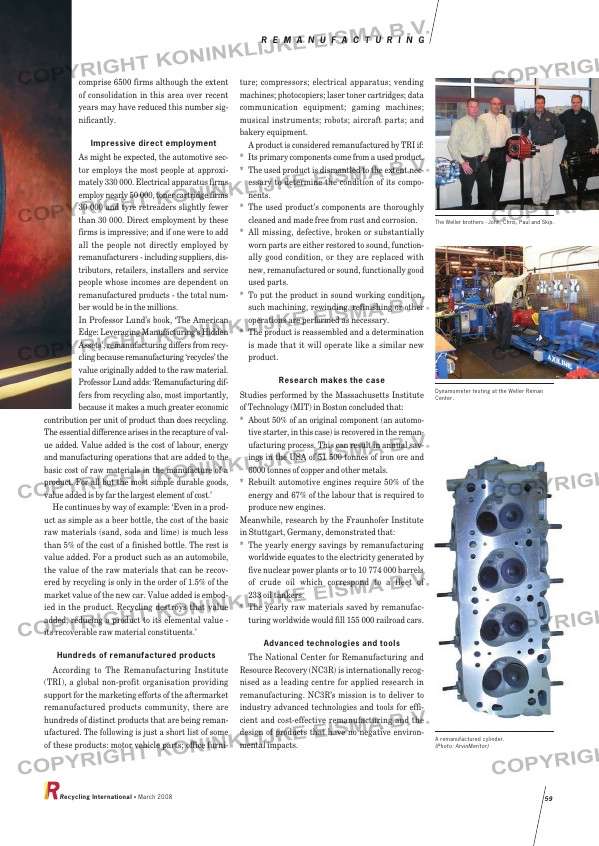Page 59 from: March 2008

comprise 6500 firms although the extent
of consolidation in this area over recent
years may have reduced this number sig-
nificantly.
Impressive direct employment
As might be expected, the automotive sec-
tor employs the most people at approxi-
mately 330 000. Electrical apparatus firms
employ nearly 50 000, toner cartridge firms
30 000 and tyre retreaders slightly fewer
than 30 000. Direct employment by these
firms is impressive; and if one were to add
all the people not directly employed by
remanufacturers – including suppliers, dis-
tributors, retailers, installers and service
people whose incomes are dependent on
remanufactured products – the total num-
ber would be in the millions.
In Professor Lund’s book, ‘The American
Edge: Leveraging Manufacturing’s Hidden
Assets’, remanufacturing differs from recy-
cling because remanufacturing ‘recycles’ the
value originally added to the raw material.
Professor Lund adds: ‘Remanufacturing dif-
fers from recycling also, most importantly,
because it makes a much greater economic
contribution per unit of product than does recycling.
The essential difference arises in the recapture of val-
ue added. Value added is the cost of labour, energy
and manufacturing operations that are added to the
basic cost of raw materials in the manufacture of a
product. For all but the most simple durable goods,
value added is by far the largest element of cost.’
He continues by way of example: ‘Even in a prod-
uct as simple as a beer bottle, the cost of the basic
raw materials (sand, soda and lime) is much less
than 5% of the cost of a finished bottle. The rest is
value added. For a product such as an automobile,
the value of the raw materials that can be recov-
ered by recycling is only in the order of 1.5% of the
market value of the new car. Value added is embod-
ied in the product. Recycling destroys that value
added, reducing a product to its elemental value –
its recoverable raw material constituents.’
Hundreds of remanufactured products
According to The Remanufacturing Institute
(TRI), a global non-profit organisation providing
support for the marketing efforts of the aftermarket
remanufactured products community, there are
hundreds of distinct products that are being reman-
ufactured. The following is just a short list of some
of these products: motor vehicle parts; office furni-
ture; compressors; electrical apparatus; vending
machines; photocopiers; laser toner cartridges; data
communication equipment; gaming machines;
musical instruments; robots; aircraft parts; and
bakery equipment.
A product is considered remanufactured by TRI if:
* Its primary components come from a used product.
* The used product is dismantled to the extent nec-
essary to determine the condition of its compo-
nents.
* The used product’s components are thoroughly
cleaned and made free from rust and corrosion.
* All missing, defective, broken or substantially
worn parts are either restored to sound, function-
ally good condition, or they are replaced with
new, remanufactured or sound, functionally good
used parts.
* To put the product in sound working condition,
such machining, rewinding, refinishing or other
operations are performed as necessary.
* The product is reassembled and a determination
is made that it will operate like a similar new
product.
Research makes the case
Studies performed by the Massachusetts Institute
of Technology (MIT) in Boston concluded that:
* About 50% of an original component (an automo-
tive starter, in this case) is recovered in the reman-
ufacturing process. This can result in annual sav-
ings in the USA of 51 500 tonnes of iron ore and
6000 tonnes of copper and other metals.
* Rebuilt automotive engines require 50% of the
energy and 67% of the labour that is required to
produce new engines.
Meanwhile, research by the Fraunhofer Institute
in Stuttgart, Germany, demonstrated that:
* The yearly energy savings by remanufacturing
worldwide equates to the electricity generated by
five nuclear power plants or to 10 774 000 barrels
of crude oil which correspond to a fleet of
233 oil tankers.
* The yearly raw materials saved by remanufac-
turing worldwide would fill 155 000 railroad cars.
Advanced technologies and tools
The National Center for Remanufacturing and
Resource Recovery (NC3R) is internationally recog-
nised as a leading centre for applied research in
remanufacturing. NC3R’s mission is to deliver to
industry advanced technologies and tools for effi-
cient and cost-effective remanufacturing and the
design of products that have no negative environ-
mental impacts.
Recycling International • March 2008 59
R E M A N U F A C T U R I N G
The Weller brothers – John, Chris, Paul and Skip.
Dynamometer testing at the Weller Reman
Center.
A remanufactured cylinder.
(Photo: ArvinMeritor)
RI_020 Remanufacturing:Opmaak 1 28-02-2008 11:46 Pagina 59



